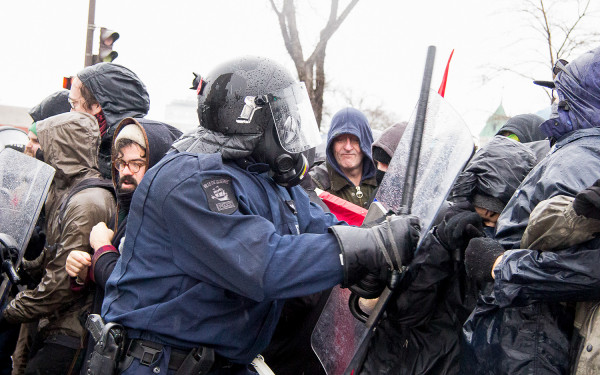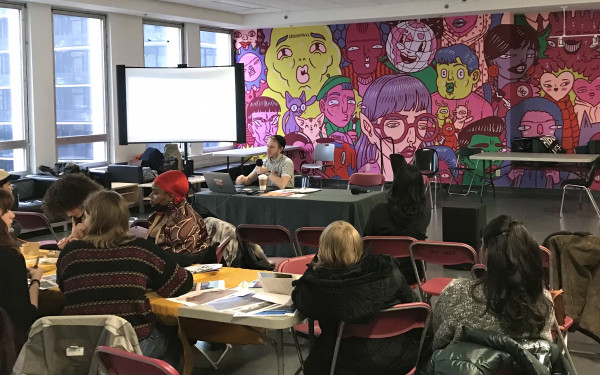Fighting the Fascist Problem on University Campuses
Anti-Fascism Requires Links With the Community
Quebec has a fascism problem.
Not to single the province out, of course—I’m sure there are Nova Scotian nazis too. But in the past year or so, Quebec has seen a surge of far-right demonstrations and violence.
Over a year ago, I joined up with the Resist Trump and the Far Right Network. We brought together a wide coalition of activists and community organizers to denounce the inauguration of the 45th President of the United States, leading a rally in Montreal as The Donald was sworn in south of the border. At the time, the mood was hopeful. There were hundreds of us, the streets were ours. We were met with cheers from onlookers and supportive honks from passing cars.
Fast-forward a year.
There have been several incidents of racist violence directed towards Quebec’s Muslim population. Fascist groups like Storm Alliance and La Meute collaborated with Quebec City police to crush anti-fascist protesters. Quebec City police deny that they even have records of their interactions with these groups, despite the threat of violence central to their politics. Things do not look good.
Granted, anti-fascist groups have risen admirably to the occasion. Montreal’s Food Against Fascism collective has carved out a chunk of Norman Bethune Square to serve hot meals every weekend, no questions asked. It’s a relatively low-risk way to get the word out, and meet the immediate needs of folks in pretty precarious situations.
A lot of community activism is centred around this approach—meet the people where they’re at, help out where you can, force any fascist presence out of the neighbourhood.
But the streets aren’t the only place fascists organize. Increasingly, they’ve been crawling out of the woodwork on university campuses as well. Concordia is no different. On my way to help serve at last week’s Food Against Fascism, I had to cover up a trail of neo-nazi stickers steadily working from St. Mathieu St. towards the Hall building.
I helped other organizers search the surrounding area, and we found that they clustered around the Hall Building itself. Those stickers have since been covered up—they now read “Refugees Welcome” or “Support Your Local Antifa.”
But this isn’t the first time Concordia’s experienced an unsightly rash of far-right stickers. In the fall, recruitment posters for a so-called “European heritage” movement started cropping up. They were particularly common at the Loyola Campus, but we still spent a day tearing posters off downtown lampposts.
That week was the second time in less than a year, after years of silence from Concordia’s extreme right. Why now? What makes university students such an appealing target for nascent fascist groups? To understand this, it helps to develop a working definition of what fascism actually is.
It helps to think of fascism not as a form of government, but a reaction to the loss of middle-class security. Essentially, the comforts of the middle class are products of imperialism. These are preserved through constant expansion.
But when this expansion falters, the middle class cannot hold on to that position. To rectify this, they begin advocating for internal expansion. Citizenship is tied to concepts like ethnicity to justify the application of imperial conditions to marginalized members of society, temporarily preserving the safety of the middle class.
The category of “human” shrinks rapidly as the capitalist serpent eats its own tail. The process by which this happens is fascism, and the people who advocate for this are called fascists.
This is important because the university system, Concordia included, is a middle-class institution. Students from mostly middle-class families come to receive what amounts to training to reproduce this class structure.
In addition, the university is centred around the language and ideology of liberal “merit”—if you fail, it’s your own fault for not having enough of some internal, innate ability. If you succeed, it’s because you’re better than people who are oppressed.
This combination, of a middle-class threatened by the collapse of that class and a university culture centred around natural hierarchy, presents a massive target to nascent fascist groups. To capitalize on this “perfect storm” of conditions, the far-right employs a wide array of tactics. To counter them, though, we first need to recognize them.
The stickers and posters I mentioned above are a hugely popular one. A small group of people can cover a wide area relatively quickly, while maintaining their anonymity as they build support. These are relatively easy to spot and cover up when, like recently, they rely on stereotypical neo-nazi imagery. Swastikas, runic fonts, invocation of historical fascists—these are all easily identifiable.
Now that we know what a contemporary fascist looks like, we need to dig our heels in, and kick them off our campuses. — Eamon Toohey
But it becomes much more difficult when groups start to adapt their rhetoric specifically to university targets. Swastikas are exchanged for more obscure Latin or Nordic icons, and a wannabe-stormtrooper aesthetic is exchanged for something much cleaner.
Rhetorically, these groups stop short of openly declaring themselves fascists. “White pride” is too bloodstained a banner for them to publicly fly. Instead, they rally behind calls to defend “European identity” from immigrants, migrant workers, and refugees.
They paint themselves as defenders of “free speech,” pretending that the civil liberties issue of our times is that they aren’t allowed to spout vitriol about people of colour and trans folks. This new dressed-up fascist variant has a great deal of pull on campuses. There’s an audience of young, disaffected white men eager for any explanation to the instability of their social position.
This rhetoric isn’t just limited to posters and stickers, either. It crops up a lot online as well. I try and stay out of places like Spotted Concordia, but every now and then things leak out. Things like self-declared Proud Boys braying for right-wing pseudo-intellectuals to come speak at Concordia.
Not all of these future guests are out-and-out fascists, or even closet fascists. Some of them just repackage core tenets of liberalism as Chicken Soup for the Petty Bourgeois Soul self-help books. But their presence attracts a lot of actual fascists, the kind of people who flock to videos titled “BASED PROFESSOR TRIGGERING LIBERAL SNOWFLAKES !!!1!!” By relying on the authority and respectability of these figures—essentially the liberal meritocracy I mentioned above—campus fascists are able to network.
They use dog whistles buried in these speakers’ rhetoric to seek out other diehards. A particular favorite is decrying the “cultural marxism” supposedly taking over our universities. To the uninitiated, it sounds just like the tired old critique of universities being more left than the general population.
But to a fascist sympathiser, “cultural marxism” is a specific conspiracy theory that Jewish communists are saturating our popular media with left-wing ideology to eradicate western civilization. It dovetails neatly with online neo-nazis’ penchant for using a triple parentheses to mark things related to a supposed Jewish conspiracy.
It doesn’t matter if the speakers they want to bring to universities like Concordia actually believe these things. They recognize there’s an audience for it, and fledgling campus fascist groups will exploit that as soon as they can.
Now that we know what a contemporary fascist looks like, we need to dig our heels in, and kick them off our campuses.
Concordia has a long history of student activism, stretching back almost 50 years. But most of our activist history has been focused around fighting institutional injustice, not burgeoning movements.
On the bright side, that means we can nip the university far-right in the bud before it becomes an institutional problem. More dishearteningly, however, our old tricks are no good. Not that petitions have ever done much good, but they aren’t worth the paper they’re printed on now. There’s no court of public opinion, simply because fascism has no obligation to debate in good faith.
Instead, we need to completely deny them a platform. This means realizing the right to speak and the right to an audience aren’t the same thing. If we can deny the far-right an audience, they’re just racists howling into the void. We can disrupt their events, take up their space, and make sure every attempt to find an audience is met with mass resistance. From stickers to speaking tours, we can’t allow fascists to hold the floor.
On a more institutional level, we need to demand more of our university and our departmental associations. If a fascist pseudo-intellectual is spewing bullshit and using his scholarly reputation to give it weight, call on departments in his field to condemn him. This is bound up in the liberal meritocracy of the university—failure is a personal fault, and leads to a stripping of merit and authority. Since we can’t undo that tomorrow, we need to mobilize it against right-wing extremists until we can undo it.
This extends to our own decision-making bodies as well.
Full disclosure, I’m a member of the CSU Council. I was one of the councilors working to get an anti-fascist position on the union’s books. It’s been there for months, and very little has come of it.
We’ve endorsed a few demonstrations, brought contingents to some of the more respectable ones, but that’s all. There’s little individual counselors can do in the day-to-day workings of the union without quorum and agenda points, but executives and staff have a great degree of freedom to pursue tasks related to their mandate.
We should be creating links not just within the university, but between university and community organizations. We should be running widespread popular education campaigns, working with other groups to determine who exactly is being targeted for radicalization by right-wing extremists, and countering them.
We should be showing up. Not just to demonstrations, but to organizational meetings, to food servings, to anywhere marginalized people need support. Not to push our narrative or to hawk flyers, but to show our solidarity for people who are affected in diverse ways by the rise of the far-right.
When you punch a fascist, the whole world needs to punch with you. Not necessarily by being in the street with you, but by building links between our communities, by meeting people where they’re at, and by fostering meaningful resistance within our institutions.





01_600_375_90_s_c1.jpg)
2_600_375_90_s_c1.jpg)